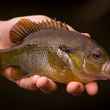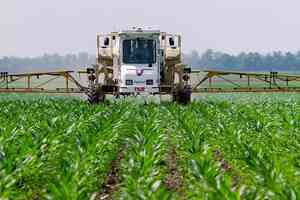The answer is: The American public.
The question was: Who is forced to buy fuel that costs more to produce than gasoline, reduces mileage, damages boat, car and truck engines and gas tanks, destroys fish and wildlife habitat, pollutes air and water, and makes America more dependent on foreign oil?
With its 1990 amendments to the Clean Air Act, Congress tried a revolutionary strategy: regulating not just how gasoline was burned in motor vehicles but how it was made. The idea was to require gasoline to be spiked with oxygen-containing chemicals (oxygenates) in areas where clean-air standards weren't being met. This way, more carbon monoxide would get burned.
Corn Belt politicians who had pushed this "reformulated-gasoline program" were ecstatic. The amendments created a new future for the corn-produced oxygenate ethanol (a.k.a. "white lightning" or grain alcohol), which hadn't found a decent market for anything save drinking despite $5 billion in federal subsidies.
With the mandated use of "gasohol" (one part ethanol, nine parts gasoline), the moribund ethanol industry would spring heel-clicking from its wheelchair. Agribusiness would prosper. And America would get cleaner air and homegrown energy. It would be a win-win-win-win.
But the only winner has been the ethanol industry, transmogrified by forced gasohol use to a sacrosanct, pork-swilling behemoth that gets bigger and hungrier with each feeding. In 1990, 50 ethanol plants produced 900 million gallons of ethanol. In 2024, 187 ethanol plants produced 16.22 billion gallons, accounting for 45 percent of the nation’s corn production.
Gasohol gets a per-gallon tax break of 5.4 cents from the 18.4-cent federal gasoline excise tax. And companies that blend ethanol get federal tax reductions. When the Volumetric Ethanol Excise Tax Credit expired in 2011 it had cost taxpayers $5.7 billion. These days, subsidies for ethanol production are embedded in such government initiatives as the Renewable Fuel Standard mandate and tax breaks for ethanol blender pumps.
Some Corn Belt states make direct payments. Minnesota and Nebraska award ethanol manufacturers a 20-cent-per-gallon "producer incentive."
The main recipients of all this state and federal loot aren't family farmers but bloated agribusiness corporations. For example, the nation's biggest ethanol producer, POET Biorefining with a production capacity of 2.7 billion gallons per year from its 33 plants, gets further engorged by $16.9 million in annual tax credits, rebates, and grants from Iowa, Indiana and South Dakota.
Of all crops grown in the United States, corn demands the most massive fixes of herbicides, insecticides, and chemical fertilizers, while creating the most soil erosion.
Ethanol — which costs significantly more to produce than gasoline when you factor in associated expenses for insecticides, herbicides, fertilizers and fuel-swilling farm equipment, to mention just a few unreported costs — must be shipped separately from gasoline and mixed on-site. And because ethanol evaporates so rapidly, it can be added only to a special and expensive "blendstock" of gasoline.
Ethanol comes with enormous environmental costs. For instance, it evaporates faster than gasoline. So while gasoline reformulated with ethanol releases less carbon monoxide, it releases more volatile organic compounds, hydrocarbons, and oxides such as ozone, a main ingredient of smog.
And ethanol plants are major sources of air and water pollution. Archer Daniels Midland — the agribusiness giant that operates seven ethanol plants in Nebraska, Iowa, Illinois, and Minnesota with annual production of 1.6 billion gallons — settled an EPA enforcement case by agreeing to put in $340 million worth of pollution controls, spend $6.3 million for retrofitting school buses with diesel engines, and pay a $4.6 million in civil penalties.
A battle now rages over a proposed 2,500-mile, $8.9 billion pipeline to move carbon pollution from ethanol plants in Iowa, Minnesota, Nebraska, North Dakota and South Dakota to underground storage in North Dakota. The project has been approved in Iowa, Minnesota and North Dakota where private property would be seized by eminent domain. But there’s a new law in South Dakota that prohibits eminent domain for carbon-capture pipelines.
Just how "sustainable" and "renewable" is corn? "To really answer that," says Cindy Hildebrand, founding member of the Iowa Prairie Network, “one has to consider how much soil is washing into creeks, how much nitrogen is swirling down to the Gulf of Mexico, how much formerly unbroken prairie is being broken as the subsidized Corn Belt grows, how much herbicide pelts down upon the land each year."
I took her advice, learning that soil is being lost from corn plantations about 12 times faster than it’s being rebuilt, and that meeting the fuel requirements of just one year's worth of U.S. population growth with straight ethanol (assuming each baby lived 70 years) would require: 52,000 tons of insecticides, 735,000 tons of herbicides, 93 million tons of fertilizer, and the loss of 2 inches of soil.
Via the fermentation/distillation process, each gallon of ethanol produces 12 gallons of sewage-like effluent which is added to the toxic, oxygen-swilling stew of nitrates, chemical poisons and dirt excreted from Midwest corn monocultures. This pollutes the Mississippi River and its tributaries, harming fish all the way to the Gulf of Mexico where it creates a bacteria-infested, algae-clogged, anaerobic "Dead Zone" lethal to crustaceans, mollusks, fish and virtually all gill breathers. In 2024 this Dead Zone covered 6,705 square miles — about the size of New Jersey.
Each year an estimated 1.6 million metric tons of nutrient fertilizer enters the Gulf of Mexico. In 2014 federal, state and tribal interagency Mississippi River/Gulf of Mexico Hypoxia Task Force set a goal of a 20-percent reduction in this pollution by 2025. But no such reduction has happened.
Where does all the land to grow the extra corn needed for ethanol come from? In some cases from land enrolled under the Farm Bill's Conservation Reserve Program (CRP). Farmers break up virgin prairie they’ve enrolled in CRP so they can plant more corn. It's lousy land for agriculture, but they plant it because of the high price of corn brought on by the ethanol boom.
CRP — conceived not for the benefit of fish, wildlife or soil but simply to reduce surplus, government-subsidized corn — has restored two million acres of wetlands and adjacent buffers, produced 7.1 million acres of new native grasses, protected 175,000 miles of stream, restored 26 million acres of wildlife habitat and saved nine billion tons of topsoil.
And CRP annually produces something like 15 million pheasants and 2.2 million ducks while sequestering 48 million tons of carbon dioxide. Each year it provides $162 million in increased soil productivity, $122 million in increased waterfowl hunting, $629 million in increased wildlife viewing and $392 million in runoff reduction.
Thanks to CRP and other Farm Bill conservation programs, Iowa —the corn capital of the nation — is teeming with smallmouth bass and, in the state's northeast hill country, native brook trout and naturalized rainbows and browns.

"Our trout fishery is one of the best kept secrets in the country," declares environmental journalist Rich Patterson, who directed the Indian Creek Nature Center in Cedar Rapids for 36 years and serves with me on the Circle of Chiefs of the Outdoor Writers Association of America. "When I first came here, trout fishing was all put-and-take, guys tossing corn to stupid hatchery trout. I'm catching incredible wild trout in streams that were mucky in the 1980's. And there has been a tremendous turnaround on smallmouth bass. They're sight feeders, and with clearing water they're increasing like crazy."
Iowa’s native brook trout are a national treasure, genetically distinct from Yankee brook trout, Appalachian brook trout and even fish from Wisconsin and Minnesota. In 1980 only one of the state's streams had native brook trout reproduction. Today there are 53, thanks largely to CRP.
The future, however, appears bleak. This from Patterson: “CRP-protected land has shrunk as average cornfield size has greatly increased. The Farm Bureau and state government have promoted vast expansion of row-crop agriculture and support locating an enormous cattle feedlot in the headwaters of one of Iowa's best trout streams. So water quality has declined. Much of the expanded corn is used to produce ethanol, a horribly inefficient product, but good politically here. Trump’s Tariffs will reduce the price farmers get for corn, so they'll probably plant more in response. Still, fishing has been good for trout, bass, wipers [hatchery-produced white bass/striped bass hybrids], and panfish. Fishing is my escape from much of the sh*t going on now.”
Wetlands — the most productive of all fish and wildlife habitat — consume nitrogen and filter out pesticides and sediments. But wetlands are being drained to produce surplus corn. The Corn Belt has lost about 90 percent of its wetlands.
In the Western Corn Belt at least 70 percent of mixed-grass prairie and virtually all tallgrass prairie has been plowed under.
In some states corn has to be irrigated by pumps that suck water from the ground faster than it percolates back in. Moreover, the pumps are powered by natural gas, the frenzied production of which creates horrendous problems for fish, wildlife, and livestock.
But ethanol's cost to Americans goes beyond the loss of biodiversity and compromised air, water and soil. The approach has been: Don't invest to make ethanol more affordable; pour corporate welfare into ethanol producers to make cleaner-burning gasoline less affordable. Corn belt politicians defend ethanol production because it “helps farmers expand their markets.” By that logic we should force everyone in America, deep South included, to buy snowblowers to help Briggs & Stratton, Honda, Toro and Craftsman “expand their markets.”
If you're talking to an ethanol fan and the conversation starts to drag, bring up the name of the late Dr. David Pimentel, the Cornell University agricultural scientist, the first researcher to study the economics, efficiency, and alleged environmental benefits of ethanol, and who chaired a U.S. Department of Energy panel that investigated these issues. After the expletives, you'll be directed to biostitutes who proclaim that ethanol is an elixir for what ails the earth.
Pimentel calculated the real energy costs of raising corn, including the enormous amounts of fossil fuel required to power irrigation pumps, run planting and harvesting machinery, cook the corn in the fermentation/distillation process, and make the fossil fuel-based nitrogen fertilizer that corn growers are hooked on.
Without even factoring in the fuel that's required to ship ethanol to blending sites, Pimentel found that it takes about 70 percent more energy to produce ethanol than the energy that’s in ethanol. Then, figuring in state and federal subsidies, he found that ethanol costs $2.24 a gallon to produce, compared with 63 cents for gasoline.
What’s more, Pimentel found that other costs of allocating corn to ethanol production include higher food prices. "Increasing the cost of food and diverting human food resources to the costly, inefficient production of ethanol fuel raises major ethical questions," he wrote. "These occur at a time when more than half of the world's population is malnourished. The ethical priority for corn and other food crops should be for food and feed. Abusing our precious croplands to grow corn for an energy-inefficient process that yields low-grade automobile fuel amounts to unsustainable, subsidized food burning."
Pimentel chided the USDA for not fully taking into account energy values for such things as the operation and repair of farm machinery, for the fossil fuel-based fertilizers required for corn production and for taking planting and yield data only from the states with the best soils and productivity.
If Trump really wants to slash wasteful government spending, decrease our dependence on foreign oil, and prove he wasn’t lying when he said he wanted America to have "among the very cleanest air and cleanest water on the planet," he needs to take his chainsaw to the grotesque boondoggle of mandated gasohol use.

































Comments